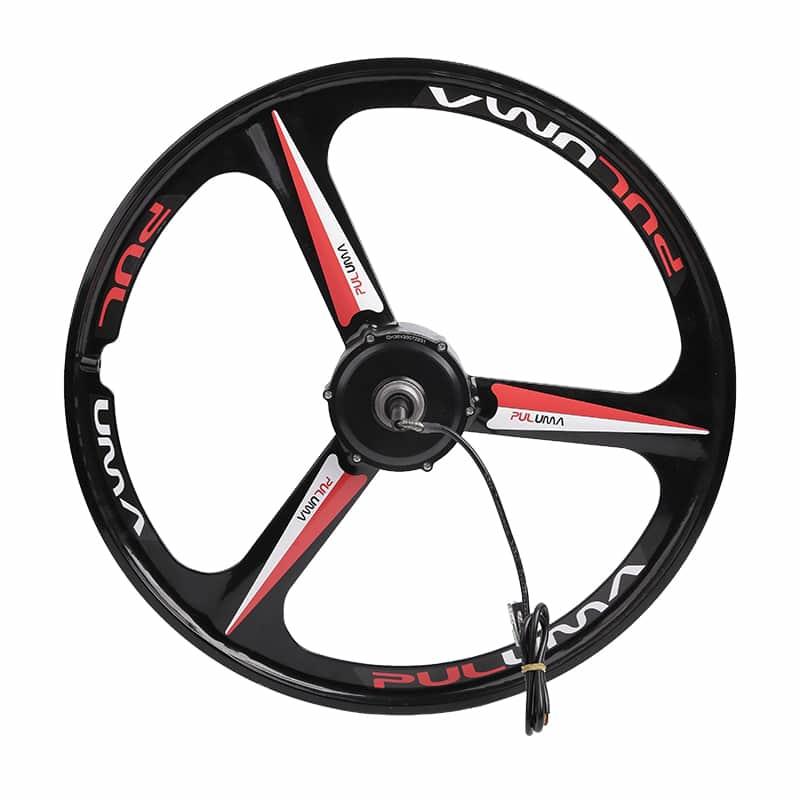

1. Introduction
As the name suggests, a motor wheel is a drive device that integrates a motor directly into the wheel. With the increasing popularity of electric vehicles, motor wheels have become a key technology in the fields of intelligent transportation and automation due to their compact structure, rapid power response, and high energy efficiency.
2. Basic Structure and Operating Principle of a Motor Wheel
Components of a Motor Wheel
The core components of a motor wheel include the motor body, the hub structure, and the control and sensing system. The motor body generally consists of a stator and a rotor. The stator is the stationary part containing the winding coils, while the rotor is the rotating part, usually connected to the wheel. The hub structure supports the entire device, ensuring mechanical strength and proper operation of the wheel. Sensors and control modules monitor the motor status for precise driving and safety protection.
Operating Principle
A motor wheel primarily converts electrical energy into mechanical power through the principle of electromagnetic induction. When energized, the stator winding generates a rotating magnetic field, which drives the rotor to rotate, thereby driving the wheel. In-wheel motors eliminate the drive shaft and gearbox in traditional transmission systems, making power transmission more direct and efficient. Introduction to Different Types of Motor Wheels
Motor wheels can be categorized as brushed or brushless based on motor type. Brushless motors are becoming increasingly mainstream due to their high efficiency, long lifespan, and simplified maintenance. There are also DC and AC motors, with AC motors generally being more efficient and suitable for higher-power applications.

3. Key Technologies for Motor Wheels
Materials and Manufacturing Processes
To achieve lightweight design while ensuring strength, motor wheels are typically made of high-strength aluminum alloys or composite materials. Lightweight design helps reduce vehicle weight and improve range. Manufacturing processes include precision casting, CNC machining, and high-precision winding manufacturing to ensure motor performance and durability.
Cooling Technology
Motor wheels generate significant heat during operation, making heat dissipation design crucial. Common solutions include passive cooling (heat sinks, wheel hub ventilation) and active cooling (fans, water cooling systems). Good heat dissipation ensures stable motor performance and extends service life.
Control System
The motor wheel is equipped with a dedicated controller that regulates current and voltage for precise speed and torque control. Combined with sensor feedback (such as Hall effect sensors and temperature sensors), the control system enables intelligent driving, fault protection, and energy recovery. Efficiency Optimization
The energy efficiency of motor wheels is continuously improving through optimized winding design, reduced mechanical friction, and improved electronic control algorithms. Efficient energy conversion reduces battery consumption and extends battery life, which is crucial for products such as electric vehicles.
4. Key Applications of Motor Wheels
Electric Bicycles and Electric Scooters
Due to their compact structure and easy installation, motor wheels are widely used in lightweight electric vehicles, significantly improving the efficiency of short-distance urban travel.
Electric Vehicle Hub Motor Systems
In new energy vehicles, hub motors can directly drive the wheels, saving space, improving power response speed, and promoting the development of smart electric vehicles.
Robots and Automation Equipment
Motor wheels provide robots with flexible mobility and are widely used in logistics handling, inspection robots, and other fields.
Industrial Machinery and Special Vehicles
For example, mining vehicles and agricultural machinery use motor wheels to achieve powerful power and efficient control.
Smart Mobility Platforms
Emerging applications such as unmanned delivery vehicles and smart cars are increasingly relying on motor wheel technology, driving the development of smart cities.
5. Advantages and Challenges of Motor Wheels
Advantages
Compact structure: Eliminating traditional transmission components reduces overall weight. Fast Power Response: Direct drive enables more responsive acceleration and braking.
Easy Maintenance: Reduced mechanical wear reduces maintenance frequency.
Challenges: Heat dissipation: Limited wheel hub space makes heat dissipation design complex.
Cost: High-performance motors and controllers are expensive.
Durability and Safety: The motor wheel is subject to complex operating conditions, requiring high durability and safety design requirements.
Control Complexity: The motor and vehicle systems require high integration and coordination.
6. Future Development Trends:
Intelligence and Networking: The motor wheel will integrate more sensors to enable intelligent diagnosis and remote monitoring, promoting the development of connected vehicles and intelligent transportation systems.
New Materials and New Processes: Advanced materials such as carbon fiber and innovative manufacturing technologies such as 3D printing will enable lighter and stronger motor wheels.
Multifunctional Integrated Drive System: Integrates braking, suspension, and other functions to improve overall vehicle performance and comfort.
Sustainable Development and Environmentally Friendly Design: Utilize environmentally friendly materials and low-energy designs to promote green transportation.